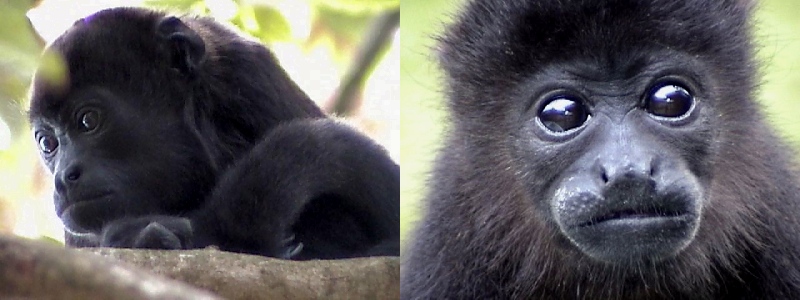Mantled Howling Monkey
Alouatta palliata (Gray, 1849)
Physical Description
Mantled howling monkeys are so named for the fringe of long gold-brown hair along their sides (a mantle). The rest of their hair is black and relatively short. Skin is black; the face, palms, bottoms of feet, and the underside of the tail tip are hairless. When males reach adulthood, their scrotum turns from black to white. During estrus, the genital area of females changes from white to pink. Sexually dimorphic by size, the mean body weights of males and females are 7.15 kg and 5.35 kg, respectively (Ford & Davis 1992). The hyoid bone is larger in males than females, and is expanded into a large, hollow, resonating chamber. This produces the roaring howls after which the howling monkeys were named (Fleagle 1988).
Locomotion
While howlers are quadrupedal, a prehensile tail is essentially a fifth appendage, and is often used as such. All five limbs may be used during climbing, with the muscular tail serving as an additional support. Howling monkeys rarely leap; their tail enables them to cross gaps by bridging (stretching). Tails are also used during suspensory feeding, and increase the amount of food sources available by extending reach by up to 150% (Ford & Davis 1992). Adults suspend themselves most often while foraging, but juvenilles will hang from, and even walk (upside-down) under the branches during play. Howlers never brachiate (swing below the branches).
Howlers spend the vast majorty of their lives in the upper canopy of the forest; they do not move well on the ground and rarely leave the trees. They may decend when a tree with food is too far to bridge. They may decend by falling out of the branches. Howlers of all age groups have been reported to fall out of trees, and remains often show signs of broken bones (Rowe, 1996).
Distribution & Habitat
The mantled howling monkey is distibuted throughout Central and South America, from eastern Mexico south through Panama, and west of the Andes from Columbia to northern Peru (Emmons 1997). They use all forest levels, but most frequently the upper canopy and emergents. (Mittermeier, 1988). Relatively small home ranges enable them to survive in small fragments of forest (Emmons 1997). They are found in mature and old secondary evergreen, riverine, semi-deciduous, rain forest, and cloud forest up to 2000 m (Emmons 1997; Rowe 1996).
Home ranges are 10�60ha (25-148acres), but mantled howlers generally use only the 40 percent of this area where preferred food sources are located (Milton, 1980; Rowe, 1996). Due to the reliance on such a common food item as leaves, day ranges are small, often less than 100 m, with a mean travel distanve of 433 m (Mittermeier, 1988). Howlers do not have specific territories; they tend to defend wherever they happen to be at the moment (Mittermeier, 1988). Home ranges may overlap up to 100% (Rowe 1996).
Activity Patterns
Howling monkeys are diurnal. Their day begins with a "dawn chorus" of howling roars either just before or just after sunrise. Foraging usually follows, and alternates with periods of resting throughout the day. On an average day, the majority of time is spent resting (74%) and foraging (15-22%), with little time devoted to traveling (Fleagle 1988; Rowe 1996). The time spent resting usually increases along with temperture and rainfall. Howlers do not build nests; they sleep on the branches of the upper canopy, singly or in small groups.
Seasonal changes affect the amount of time devoted to specific activities. With the increased availability of high-energy food sources (fruits) in the wet season, howlers spend more time feeding and less time resting than they do in drier months. More travelling is required in the dry season, when food sources are scarce and spread out. The low-energy leaves that make up most of the diet during these months require that a greater proportion of time be devoted to resting. Regardless of the season, mantled howlers are travel minimizers; the less time spent travelling, the more energy is conserved, thereby increasing the efficiencay of foraging (Smuts 1987).
... This article is incomplete ...
see also:
The Influence of Weather Patterns on the Activity Levels of the Mantled Howling Monkey - results of research conducted in NE Costa Rica, January of 1998.
for more information:
- The Foraging Strategy of Howler Monkeys : A Study in Primate Economics by Katharine Milton.
- Field Study of the Behavior and Social Relations of Howling Monkeys by Clarence R Carpenter.
The background pattern on this page is by squidfingers.
The images on this page are for educational purposes, and as such their use is in accordance with the policy of The Primate Foundation of Panama.
